
On the sanctuary waringin’s shadow,
old black locomotive with the struck of “Louis Victor Robert Schwartzkopff”
and two carriages for passenger and equipment halts
on the emplacement in front of the workshop.
The whistle cries, white smoke spreads in to the morning sky.

Accross the Rain Tree Forest (Samanea saman)
22 kilometers:
Ledok, Kendilan, Pasar Sore, Blungun, Nglobo, Cabak and Nglebur
ON MISSION
We came together at Tjepoe, a border town between Central Java and East Java. Our destination: 22 kilometers cruising with old locomotive the extensive and exotic state ownership teak forest in the end of August 2010. In Netherlands Indies, Tjepoe was a part of Rembang Residency. This town has abundant resources of oil and teak wood.
Tjepoe teak forest is managed by Kesatuan Pemangku Hutan PERHUTANI Cepu, East Java. Accompanied by Budi Dharmawan, Hafidz Novalsyah, and Christiantowati, we were assigned for National Geographic Traveler. This journal is consisting the behind of scene of our assignment.
ACKNOWLEDGEMENTS
I would express my gratitude to Andiriana, Administrator of KPH PERHUTANI Cepu. This enthusiastic man who manages the high conservation value forest of 37.000 hectares that supported by 12 asistances and 43 chief of forest resort warders. He arranged the forest as national food security stock. “The food land cultivation is shrinking, whereas the forest remains unvarying,” he says.
“The forest security should be based on the togetherness between society and state.”
MAP OF TJEPOE
Topography and City Map

Red point is location Tjepoe, whereas the yellow is Samarang.
Java Madura Bali (excerpt)
2nd Edition
Published by Washington D.C., U.S. Army
1944–1945
Based on Survey in 1944
Source: KIT

The white area was teak forest that managed by Boswezen (state forestry).
Java Res. Rembang (excerpt)
Herzien door den Topografischen dienst in 1922-1923
Blad XLV C. – Blad XLVI A.
Source: KIT
BERLINER MASCHINENBAU – ACTIEN GESELLSCHAFT
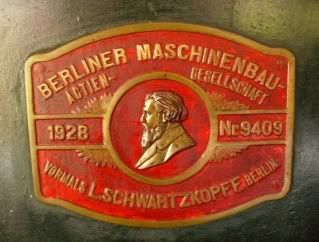
The factory was founded by Louis Victor Robert Schwartzkopff on 3 October 1852
as Eisengießerei und Maschinen-Fabrik von L. Schwartzkopff in Berlin.
Biography of Louis Victor Robert Schwartzkopff
5th of June 1825 – 7th of March 1892
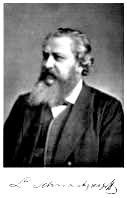
5 June 1825
He was born in Magdeburg.
1831–42
Attended the grammar school in Magdeburg
1842–45
Attended the trade institute (Gewerbeinstitut) founded by Wilhelm Beuth in Berlin.
1845–47
Practical training at the firm of Borsig. Schwartzkopff finished his training with a six-month post as an engine driver on the Berlin-Hamburg Railway.
1847–51
Chief mechanical engineer (Maschinenmeister) of the Magdeburg-Wittenberg Railway.
1852
Together with Nitsche, Schwartzkopff founded “The Schwartzkopff and Nitsche Iron Foundry & Engineering Works” (Eisengießerei and Maschinenfabrik Schwartzkopff and Nitsche) in Berlin.
1853
Schwartzkopff ran the firm as the only owner.
1870
“The Berliner Maschinenbau AG vorm. L. Schwartzkopff “ emerged.
He was the general manager of the company
1888
He was pulled out of the firm entirely.
1860’s
The company's production in support of the military and the railway industry.
Schwartzkopff being granted the title of Kommerzienrat, a historical title conferred on distinguished industrialists or financiers.
1867
Production of locomotives for the Lower Silesian-Märkische Railway began, then he moved to the general engineering side of the business to a newly-acquired site in Ackerstrasse.
1880’s
Appointed to the Council of State for the Prussian Government (Staatsrat der Preußischen Regierung).
7th of March 1892
Died as the result of a stroke. He was buried at the Dorotheenstadt cemetery in Berlin.

Steam Operator Room - Berliner Machinenbau 1928
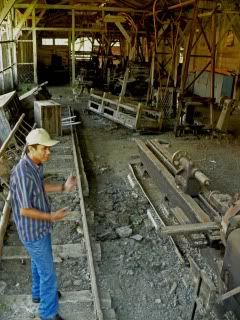
The Workshop
Andiriana, Administrator (Executive Director) of Kesatuan Pemangkuan Hutan Perhutani Cepu,
explains the utility of workshop for loco maintenance.
The Workshop was estavlished in 1911.
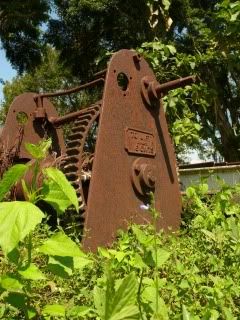
Old Rail Switch
This is a part of rail switch in the old emplacement.
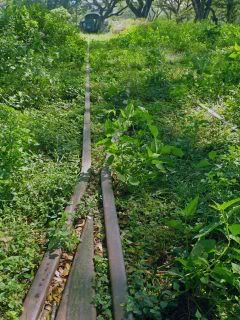
The railway networks of 1915

Bergaja - The Water Supply Tower
Reload the water in to the steam machine.

Two Sand Spreaders Reduce Slippery Railway
Yoyok (33) and Gatot (54) work on hot seat, near the steam machine.
THE SLICE HISTORY OF RAILWAY IN TJEPOE
Gerard Hendrik Verhoeven (died on13th of December 2006) who had lived in Netherlands Indies.
He has a memory about history of railway development in some cities in Java early 20th century. Since the great depression galloped the Europe in 1929, his father moved to Java and engaged by Nederlandsch Indische Spoorweg Maatschappij (NIS). Below, some information that gathered by Gerard Hendrik Verhoeven.
The tramways of "Boswezen" (State Forestry) in Tjepoe had its own rolling stock of the 3'-6"(1067 mm) gauge. In this town There was also an oil field nearby exploited by a Dutch company (BPM - Bataafse Petroleum Maatschappij) which was later to become a subsidiary of Shell Oil.
1901
The SJS (Semarang Joana Stoomtram-maatschappij) reached Tjepoe from Bloro, while an NIS tramline of 3'-6" gauge was established from Goendih to Soerabaja. The SJS built a railway yard on the northern outskirts of Tjepoe and a short line into the town with a run-around teak siding.
1903
The NIS opened its line from Goendih to Soerabaja at Tjepoe in February 1903 and connected with the SJS loop siding in the town. The main NIS line continued towards Soerabaja.
1914
NIS opened about 3 km branch to Ngareng, which came off the connection between the SJS and NIS on 1st of January 1914. NIS did all the shunting at the BPM oil plant as well as picking up loads of teak and firewood from the exchange sidings, which were placed there by the locomotive of the forestry department. A carriage for BPM employees' school children was attached to the relevant NIS trains that ran from Tjepoe station to Ngareng on 5th of October 1914.
1921
Industry expanded, more people traveled and three carriages were needed in the trains to handle the numbers traveling.
1923
The train for office workers were reduced to two carriages.
1929
The world depression took effect and the technical supervising of workshops were withdrawn (or made redundant).The NIS workshop at Tjepoe had most of its activities transferred to Lempoejangan in Jogjakarta.
1937
The train for office workers were reduced to one carriage.
1938
They were discontinued altogether on 31st of May 1938.
* * *
INSIDE THE TJEPOE TEAK FOREST
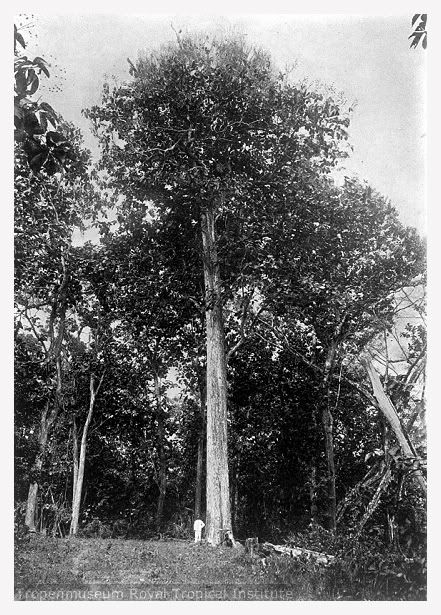
A man at a giant teak in Tjabak, Residency of Rembang early 20th century
Source: Tropenmuseum
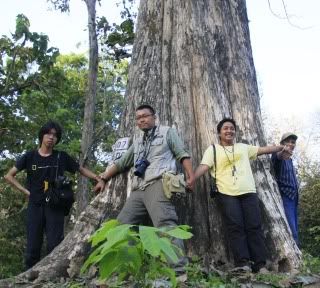
We stand together around the giant teak,
height of 25 meters and circumference of 6 meters in Pasar Sore.
Budi N.D. Dharmawan, me, Christiantowati, and Andiriana.
The former giant teak was laid down on 23rd of August 2007 in Pasar Sore, circumference of 6.9 meters and height of 25 meters. A Ngawi’s businessman bought this teak wood of Rp1 billions.
Photograph by Hafidz Novalsyah
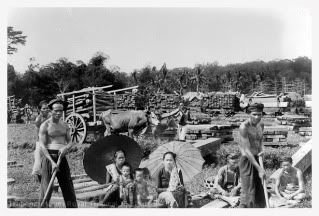
The profile of teak wood worker in Bodjonegoro, early 20th century.
Probably in Batokan village.
Source: Tropenmuseum

The present day worker in Log Storage Area, Batokan, Bodjonegoro.

The Look-out Tower in Log Storage Area
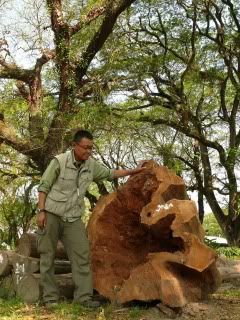
Observing the Teakwood Log
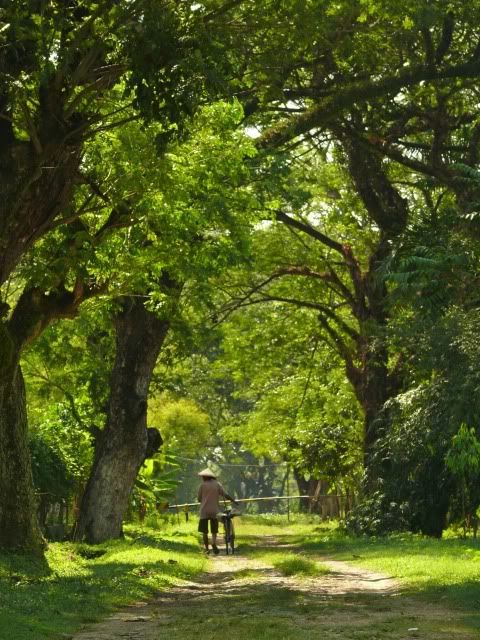
Going Home
It is not too much to say from moral of the story, we hope that our traveling would lead the train travel enlightenment for us. Like Mohandas Karamchand Gandhi who have got the sprinkle of enlightenment for right equalization after he was kicked out from the train in racial reason,
when his travel in South Africa.
LOGISTIC
Loco Tour– Perum Perhutani KPH Cepu Unit I Jawa Tengah
T: (62-296) 421352 | F: (62-296) 421849
REFERENCES
Berliner maschinenbau-a.g. vormals l. Schwartzkopff
http://www.schwartzkopff-wildau.de/home.htm#index
Louis Victor Robert Schwartzkopff
http://en.wikipedia.org/wiki/Louis_Victor_Robert_Schwartzkopff
Gerard H. Verhoeven - Railway Enthusiast
http://users.tpg.com.au/adslduwi/index.html
Kereta ini terbuka untuk umum ?
ReplyDeleteIya pak Dipo.
ReplyDeleteFungsinya lebih ke wisata. Pengangkutan kayu jati sekarang banyak menggunakan truk karena lebih murah.
Untuk rute sejauh 22 km berbiaya Rp 7-9 juta, maklum bahan bakar kayu jati dengan kecepatan rata-rata 20 km/jam.
ayo dijumlah, jadi berapa tuh :)
ReplyDeletetumben nih banyak penampakan...
ReplyDeleteserem banget tuh kereta, gimana kalo keretanya jatuh ya ???
ReplyDeletefoto paling bagus dialbum ini, menurut aku loh ya
ReplyDelete507/600 = berapa hayoo... :)
ReplyDelete507 itu nomor pohonnya
600 itu keliling pohon dalam sentimeter
Double team. Bawa 2 fotografer hehehe....
ReplyDeleteBelum pernah dalam sejarah di Brug Brosot ini kereta jatuh.
ReplyDeleteJustru seremnya saat kereta lewat, bara dari tungku pemanas ketel mesin uap jatuh bertebaran di jalan raya...
nyos...nyoss..nyosss...
Ow ya kenapa?
ReplyDeletepokoknya aku seneng deh mbacanya, lengkap n detail, makasih dik yoan...
ReplyDeleteWah makasih mbak, aku dah jarang posting nih...
ReplyDeleteiya, kenapa sih, sibukkah....(nyipain ultah, xii..xii....)
ReplyDeleteHaha...
ReplyDeleteAsyiiik mau dapet kado apa ya aku :p
waaa ikuuttt....pingin naek kereta thomas :)
ReplyDeletememang ada fungsinya pasir yang di sebarkan? (mode: oon)
ReplyDeleteReportase yg sungguh menyenangkan. Cukup detail. Saya sering klayapan di hutan Tjepoe, Randublatung dan sekitarnya di tahun 70-an dulu. Rindu celoteh burung betet yg dulu begitu khas di daerah itu. Terima kasih, bung Yoan.
ReplyDeleteHayooo sambil nyanyi:
ReplyDelete"All with different roles to play
Round Tidmouth sheds or far away,
Down the hills and round the bends
Thomas and friends..."
Supaya roda-roda kereta tidak selip... :)
ReplyDeleteWaduh 70-an, pak Tigun memang pelancong kampiun :)
ReplyDeleteWaktu itu hutan jati pasti masih rimbun ya.
Dulu zaman orba, penduduk sekitar jika masuk hutan jati bisa didor oleh polisi hutan. Hutan menajdi area terlarang.
Kini, penduduk bisa menikmati "bagi hasil" dengan perhutani. Mereka kini punya rasa turut memiliki hutan, boleh menanami hutan jati dengan tanaman pangan seperti jagung dan padi gogo.
Tapi saya tak tahu setelah lebih 30 th apakah burung2 betet itu masih berceloteh di hutan itu? Hehehe...Thx Pak Tigun!
Yoan, sempet naik keretanya gak? saya pernah naik rame-rame masuk hutannya dan makan di tengah hutan bersama sahabat museum, lupa tahun berapa. asyik lho.....
ReplyDeleteIya tentu ikutan naik juga mam...tapi sempet ketinggalan kereta juga.
ReplyDeleteuntung keretanya sering berhenti heheeh. .. :D
The bridge seems a bit rounded, caused by the train weight or by the camera lens?
ReplyDeleteHmmm...i think it was a lens distortion, mas pri.
ReplyDeletewah jadi pingin ke TKP....mantaf mas Bro...
ReplyDeletebukannya pasir menurut kita bisa bikin tergelincir...
ReplyDeleteSilakan bercengkerama dengan Berliner Maschinenbau... :)
ReplyDeleteFungsi pasir di sini supaya roda-roda loko tidak slip karena rel basah atau rel yang sudah aus.
ReplyDelete